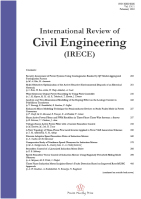


Home > Archives > Latest issue
|
International Review of
Civil Engineering (IRECE) January 2014 (Vol. 5 N. 1) 
|
by D. Islam, Y. Toda, T. Furukawa, T. Tsujimoto
Abstract - This study aims to find out the effects of sediment transport processes on removal of riparian vegetation on a braided gravel-bed river, called the Tenryu in Central Japan. Previous research shows that hydrodynamic parameter, for instance, bed shear stress and drag moment can simulate the vegetation removal condition during flood flow. However, these are not enough to estimate the vegetation removal. To minimize the error during 2-D numerical analysis, sediment transport numerical simulation has been introduced to minimize the error. Initially, sediment transport numerical simulation has been validated with actual bed level change which shows good agreement with simulation. Afterwards, spatial distribution of local scouring and deposition has been described for the year of 1982 and 2003 by using maximum flood hydrograph, respectively. Local souring depth greater than 0.5 m is considered the threshold depth to remove vegetation. About 9% of the vegetation can be removed by applying local scouring as a morphological parameter. In total, 86% of vegetation can be removed by hydrodynamic and morphological parameter. Copyright © 2014 Praise Worthy Prize - All rights reserved
Keywords: Flood Flow, Sediment Transport, Vegetation, Scouring, Deposition, Bed Level Change.
by Ahmed M. Tarabia, Mohie S. Shoukry, H. A. Razek
Abstract - The Progressive collapse is a local failure which may cause the building to be severely damaged or entirely collapsed. Both US General Service Administration (GSA) and Unified Facility Criteria (UFC) have produced two different criteria to design new buildings and to check the safety of the existing structures against progressive collapse. The main objective of this article is to compare the results obtained by both linear static and nonlinear dynamic analysis methods suggested by GSA of a building originally designed according to the Egyptian Code of Practice, and to investigate the effect of adding bracing members in the first story to prevent the successive failure mode. The building has three bays in X-direction and two bays in Y-direction with seven stories. It was concluded that designing frames to sustain earthquakes, as well as adding bracing members in the perimeter of the first floor will enhance the structure behavior against progressive failure mode. Copyright © 2014 Praise Worthy Prize - All rights reserved
Keywords: Progressive Collapse, Concrete Frames, Bracing Member, Seismic, Ductility.
by Ahmed Mahmoud Khalifa
Abstract - In this study, new technique is proposed to improve the confinement effect of the rectangular columns confined with carbon fiber reinforced polymers (CFRP) wraps. In this technique, rectangular column cross-section is divided into nearly square parts at places of CFRP wrapping by drilling slots throughout the long side of the column. The slots allow the CFRP strips to wrap around and confined nearly square parts and then filled with epoxy paste and so increasing the effective confined area of the column cross-section. An experimental program was performed to examine the proposed wrapping technique. The research examines the effect of dividing the rectangular column cross section to two squares, the effect of number of CFRP wrapping layers (i.e., CFRP thickness), and the width of each layer. The experimental results indicate that dividing the rectangular cross section to squares increase the axial column capacity. Also, using the same amount of CFRP, increasing the CFRP strips width has greater effect on increasing the ultimate load capacity rather than decreasing the width with increasing the thickness. An analytical model, conducted on rectangular columns confined by CFRP and verified using the test results, gave good agreement with the experimental results. Copyright © 2014 Praise Worthy Prize - All rights reserved
Keywords: Rectangular Column, Confined Concrete, CFRP, Confinement.
by Olufemi T. Akintayo
Abstract - Recently the author presented a note on gradient truss model by assuming that the bars can support strain gradients along their length. Hence, higher-order strain gradient terms and an internal length scale parameter (the gradient elastic coefficient) were introduced into the constitutive stress-strain relation of the truss bar element. However, in order to solve the governing higher order differential equation, extra non-classical boundary conditions are required and these need to be investigated in order to optimize proper combinations. In this paper, extra non-classical boundary conditions are studied by considering the support conditions of the bar based on imposed strain and strain gradient dominated deformation mechanisms. The quantitative response and applicability of the model under different combinations of extra non-classical boundary conditions are examined. Consequently, twelve non-homogeneous displacement-force relations are presented and form the basis for the gradient truss element stiffness matrices presented in Part II. With these, a relation between the macro-scale of the bar element and an internal length scale in the micro-scale is established thus micro-scale dependent behaviour in the material being modelled can be directly captured using this new truss bar elements. Moreover, the weakening and the strengthening effect of strain and strain gradients imposed at the bar nodes can also be revealed. As an illustration of the model a numerical example is presented. Copyright © 2014 Praise Worthy Prize - All rights reserved
Keywords: Gradient Elastic Bar, Support/Boundary Conditions, Displacement-Force Relations.
by I. Gumidi, Y. Abdelaziz, T. Rikioui
Abstract - In this work, an experimental investigation was carried out to evaluate the mechanical and durability properties of high performance concretes (HPC) containing local southwest Algerian materials. The mechanical properties were assessed from the compressive strength and the flexural strength, whilst the durability characteristics were investigated in terms of sulphate attack. The results obtained allow us to conclude that it is possible to make a high performance concrete (HPC) based on existing materials in the local market, if these are carefully selected and properly mixed in such away to optimize grain size distribution. Copyright © 2014 Praise Worthy Prize - All rights reserved
Keywords: High Performance Concrete, Local Materials, Southwest Algerian, High Strength, Durability, Sulphate Attack.
|